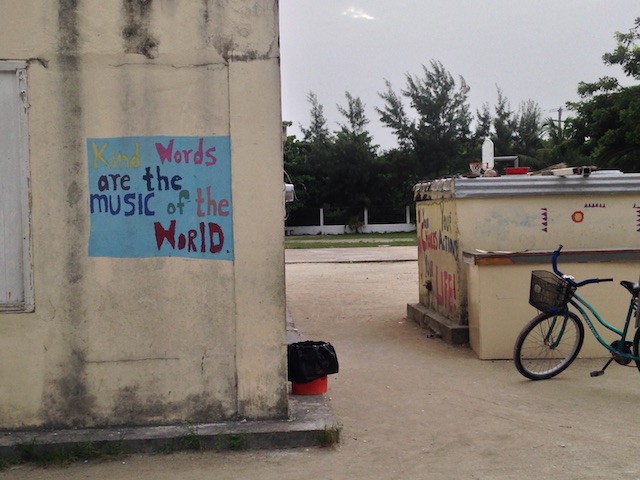
In a Belizean jungle beside the Caribbean Sea, compassion saved my life.
On the fourth day of what I thought would be two weeks of bliss in a small village at the tip of a narrow peninsula, I was kidnapped and raped at knifepoint by a man pretending to be a cab driver. No doubt we all have experiences that seem to slam into us without warning.
I’ve also noticed, thankfully, that there’s usually enough information inside every problem to point toward a solution.
For me, information came from the man himself. He was a talker. He rambled on about the problems of his life, which gave me insight into his pain. He’d been separated from his wife and son, had troubles with money and the law; he was grieving, he was angry toward the people he loved for abandoning him and he’d considered killing himself that morning.
His problems didn’t excuse his violence, of course, but it was clear, even in the chaos and confusion of the jungle, that his violence was an extension of his suffering.
Alone with the man in the jungle, I couldn’t run, hide or overpower him. My defense was to turn toward his pain, try to soothe his rage and calm his distress. It wasn’t an act. I genuinely wanted him to be well so that he’d soften enough to let me live. I gave him my full attention, listened to him rant, counseled him, even prayed over him. I needed to help him have a change of heart—about himself—so that he’d stop harming me. It worked.
It had been a mighty collision, and I was confused. I returned the following day to my home in Los Angeles feeling disjointed, my head in my stomach, my elbows in my knees. I suspected this too is part of our common human experience: we all sometimes feel rearranged.
I was a swirl of questions. What had just happened? How did my compassion dissolve his anger and help him lower his knife? Now that I was away from him, how could I hold compassion for a man I despised? Why would I even try?
As a direct result of my experience in Belize, I embarked on a study of compassion.
I started with a basic definition. Compassion is a distinct emotion that arises in response to suffering.
First, we recognize that suffering is present, either in ourselves or in another. Then, a feeling of concern arises, along with a wish for the suffering to be relieved and a willingness to help. Compassion involves turning toward the person who is suffering, rather than away, and stepping into the moment with them.
If we are the one suffering, self-compassion helps us face our own pain without denial or avoidance. Compassion is a natural human quality, yet so often personal experiences and cultural norms hinder our ability to feel, express and even receive compassion. At the same time, when we allow ourselves to give and receive compassion, it is possible to more fully connect with others and liberate ourselves.
There’s so much to learn about compassion, and learning doesn’t happen on a linear path. Still, compassion has already changed me, first in the jungle through circumstance, and now by choice. Along the way, I’ve made these observations, which I offer to you now.
To be compassionate is to be visionary.
Compassion requires attention and deep seeing. Suffering is often masked, minimized or denied, but the ability to recognize suffering is crucial to living compassionately. To practice compassion, we can learn to pay attention to our own experiences as well as the current circumstances of those around us, and be willing to see any suffering that is present. Then we can look beyond the suffering in order to hold a vision for healing.
To be compassionate is to be a student of beauty.
Though suffering and beauty coexist, suffering often overshadows beauty. To practice compassion, we can hold the dichotomy of both. There are examples of wholeness alongside brokenness. There is beauty beside, sometimes even within, the hurt. We can train our attention to include the beauty that exists in the people, situations and environments around us.
To be compassionate is to replace but with and.
When confronting suffering, but often overruns the mind.
“I love him, but he hurt me.”
“I want to help her, but I’m scared.”
“I’m in pain, but I don’t know how to ask for help.”
But establishes two things as opposites, and it can be difficult to know which of the sides to address. To practice compassion, we can try using the word and.
“I love him, and he hurt me.”
“I want to help her and I’m scared.”
“I’m in pain and I don’t know how to ask for help.”
And acknowledges the complexity of a situation, and broadens the focus, making room for a more comprehensive response.
To be compassionate requires endurance.
Compassion can be practiced and trained. It’s helpful to start where compassion already feels natural, and build endurance from there. We might practice being open and responsive to the needs of a loved one, perhaps a child, close friend or pet. Or maybe start by quieting the chaos of our own busy lives so we can be aware of the places where we suffer most. Compassion can be slippery to hold onto, and it will be easier some days than others. Increasing our capacity for compassion in one area of our lives will make it easier to practice in other areas.
To be compassionate means allowing imperfection and mess.
Responding to people with compassion means recognizing that the human condition is often messy, and this mess can cause pain for ourselves and others. To practice compassion, we can notice when we judge someone as wrong or weak. We can interrupt our tendency to make assumptions about why people behave in certain, messy ways. As we notice any unwillingness to allow people to be flawed, we can remind ourselves that all people have these things in common: we make mistakes; we suffer; we wish to be free from our suffering.
To be compassionate is to flex a new muscle.
A common misconception is that compassion makes us weak and vulnerable. Compassion doesn’t turn us into push-overs, in fact practicing compassion gives us a new muscle to flex. Compassion bolsters our physical and emotional health, reduces stress and anxiety, and enables us to more effectively respond to the day’s challenges. When we practice compassion we’re more likely to manage our emotions, and not take things other people say and do personally. As a result, we strengthen and stabilize our connections with others, which has a positive effect on our role within our families, workplaces and communities.
To be compassionate is to buck the system.
Compassion can be in direct opposition to the messages of society. For example, if the person suffering has power over us, or appears threatening or has harmed us in some way, society often revels in, even celebrates, their suffering. Are there antagonists in our lives we respond to with anger and animosity? Could we instead wish for their suffering to be relieved? Compassion can be a radical choice even in the most difficult circumstances.
To be compassionate is to say no when necessary.
Living compassionately does not mean we condone bad behavior or fail to hold people accountable for their actions. Compassion sometimes calls for a forceful, “no”. At the same time, compassion recognizes that harmful behavior is often a result of a person’s emotional pain. By compassionately responding to someone who is acting out, and addressing them at the point of their pain, it is possible to help them alleviate the problem at its source, which in turn can transform their actions and make room for healthier interactions.
To be compassionate is to get off the couch.
Being compassionate includes being willing to help, and there is often a call for action. If we wish for someone’s suffering to be relieved, but sit at a distance and watch the suffering continue, then compassion is incomplete. Compassionate action looks different in different situations. At times it will involve direct service. Other times it might be appropriate to walk away. To practice compassion, we can allow ourselves to engage in the situation, assess what might be useful and ask how we can be of service when we’re unsure.
To be compassionate is to carry on.
The world cannot be micro-managed or controlled. Difficult, hurtful situations will arise; circumstances at times may seem dire; and we may have days filled with grief, frustration and anger. One moment leads to the next, and change is inevitable.
Just as chaos can replace calm, so can loss give way to joy, and challenge dissolve into ease.
To practice compassion, we can learn to greet the moments as they come, to the best of our abilities, breathe and carry on.
~
Author: Lara Naughton
Image: courtesy of the author, flickr/Honest Reporting
Editor: Ashleigh Hitchcock






Read 7 comments and reply